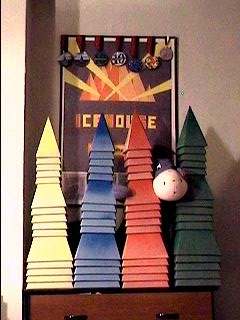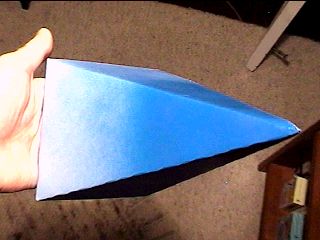Giant Icehouse Pieces
Spray Painted Cardboard

September, 2001

Explanation
Looney Labs launched a new era of piecenik obsession with
the release of
Giant
Cardboard Stashes. These are Icehouse pieces with the same
proportions as
The Martian
Chess Set, but eight times normal size.
They only come in plain white, though, but I wanted to be
able to play most pyramid games with them, I needed to somehow
color them.
The easiest way to color this much area is spray paint. It's
easy to get a nice even coat, and I didn't need to worry about
cleaning rollers or anything. I just finished painting my fourth
stash of pieces recently (now I have a full set!), and since
several people have asked for pointers, I thought I would put
my accumulated "wisdom" onto a web page anybody can use as a
reference.
Blessed are the piecemakers!
Before You Begin
- If you're planning on spray painting or sealing the pieces,
estimate 1.5 cans of spray per stash per coat. That is, if
you want to spray your pieces a solid color, and give them
two coats of paint for durability, buy three cans of paint.
- One coat is probably enough. Two is always better, though,
if you have enough time to let the first coat dry completely.
- If you only do one coat, that will mean you have a half can
of paint left over for touch-up work.
- If you've never done spray painting before, buy an extra
can of paint for practicing.
- When you're out buying paint, buy a respirator
mask. Look for one that provides protection not only
from the paint mist, but from the solvent vapors as well. These
masks are more expensive, but they're cheaper than a new pair
of lungs.
Preparing to Paint

- Find a large, well-ventilated area in which to work.
I used my carport, and waited for a bright day with a good
breeze. You really don't want to do this indoors.
[+sml]
- Unless you really don't care about the surface, cover it
with a plastic tarp or something. Don't forget that you'll be
spraying around the edges of the pieces, so unless you want
negative outlines all over the place, use a dropcloth. Also
don't forget that paint tends to spray much farther than you
expect. [+sml]
- Read all the instructions for your mask, and make sure
it fits properly.
- Lay the pieces out flat on the surface. You don't have
to crease the fold lines first, but it doesn't hurt if you've
already folded the pieces, just flatten them out before painting.
If you're not going to be painting the pieces a solid color,
creasing the pieces beforehand makes it possible to see where
the edges are.[+sml]
- Read all the instructions for your paint, including the
horrific warnings.
Painting

- Wear your mask. No kidding. I mean it!
- If you've never done spray painting before, practice on the
box before you start in on the pieces. If you're just out of
pratice, you might want to do this too, just to get warmed up.
- Keep the can moving constantly as you spray. If you hold the
can still for more than a second, paint will begin to puddle, and
it will take longer to dry. Don't worry about covering completely
in one pass, several light passes are better than one heavy pass.
- Shake the can between pieces to keep the paint mixed.
- Don't paint the "fifth side" of the pieces, or the tuck-in
tabs at the bottom, until you've painted everything else, just in
case you run out of paint. These areas aren't very visible once the
pieces are folded.
- If you're giving the pieces more than one coat, let one coat dry
completely before starting the next. If you can, wait a
couple of days. [sml]
After You're Done

- Let the pieces dry flat for an hour or two before touching them.
- You can pretty much fold them as soon as the paint is dry.
- Don't stack the pieces until the paint has dried for a couple of
days, or they might stick together.
- Expect the pieces to smell like fresh paint for a week or two.
You might want to leave them outside (under cover) while the smell
goes away. [+sml]
- If you decide that you absolutely messed up, and you hate the way
they look, turn them over and try again! The pieces fold together
just fine inside-out.
- Keep track of the manufacturers and color names of the paint you
used in case you need to repaint or replace a piece later. Sean M.
Lacy suggests writing it on a particular flap of all the 3-pointers.
"I did every large piece because large pieces are easiest to unfold,
and I didn't have to check each one to find the one I wrote on."
[sml]
- Send me a picture,
I'd love to see how yours came out.
Thanks to Sean M. "Sathya" Lacy (sml)
for some valuable additions to this document!
 [Physical Objects]
[Flourishing Branch]
[Home Page]
[Physical Objects]
[Flourishing Branch]
[Home Page]




